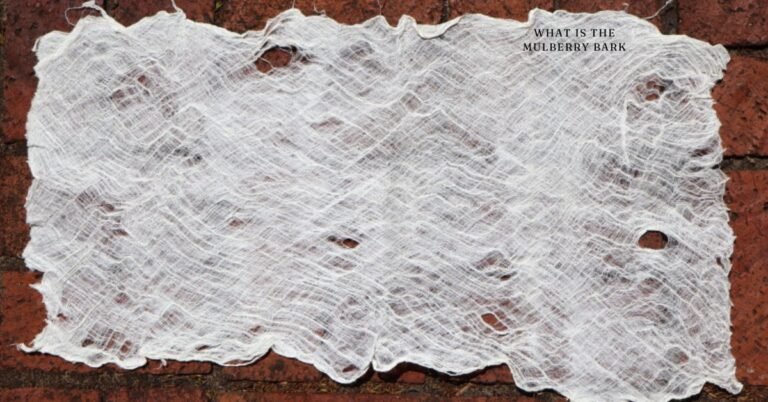People have cultivated mulberry trees for centuries for their delicious fruits and nutrient-rich leaves, but they often overlook the value of their bark. If you’ve ever wondered what is the mulberry bark, you’re not alone. Traditional medicine, textile production, and various industries worldwide have valued this natural material. In this in-depth guide, we’ll explore everything you need to know about mulberry bark, from its composition and benefits to its uses in different fields.
Understanding: What Is It?
It refers to the outer covering of trees from the Morus genus, including Morus alba (white mulberry), Morus nigra (black mulberry), and Morus rubra (red mulberry). The bark is fibrous, durable, and often used in applications requiring flexibility and strength.
Mulberry trees are deciduous and native to Asia, Europe, and North America. Their bark varies in texture and thickness, depending on the species and age of the tree. Traditionally, mulberry bark has been utilized for its medicinal properties, paper-making abilities, and contributions to various crafts.
Key Characteristics
- Texture & Appearance: Light brown to grayish, often rough with visible fissures.
- Durability: Resistant to pests and decay, making it ideal for long-term applications.
- Composition: Rich in antioxidants, tannins, and lignin, which contribute to its medicinal and industrial value.
- Harvesting: Sustainable as the bark regrows, allowing for repeated collection without harming the tree.
The versatility of mulberry bark makes it a valuable natural resource, with applications spanning across medicine, crafts, and environmental conservation.
Traditional and Modern Uses
It has been used for centuries in various industries, including traditional medicine, paper-making, and textile production. Below, we explore its most notable applications.
1. Medicinal Uses
Traditional Chinese and Ayurvedic medicine have long used it for its anti-inflammatory, antimicrobial, and antioxidant properties. Some of its primary health benefits include:
- Respiratory Health: It is used in herbal remedies to treat coughs, asthma, and bronchitis. The bark contains compounds that help reduce mucus buildup and ease breathing difficulties.
- Blood Sugar Control: Research suggests that it extract may aid in lowering blood sugar levels, making it beneficial for people with diabetes.
- Liver Detoxification: It is believed to support liver function by promoting detoxification and reducing oxidative stress.
- Anti-Inflammatory Effects: Due to its natural flavonoids and alkaloids, it is often included in herbal teas and supplements aimed at reducing inflammation.
2. Mulberry Bark in Paper and Textile Production
One of the most fascinating uses of it is in paper-making. The bark’s long, strong fibers make it an excellent raw material for handmade paper, especially in regions like Japan, Thailand, and China. Artisans prize “mulberry paper” or “kozo paper” in Japan for its durability, softness, and resistance to aging. Some cultures soften and weave mulberry bark into fabric for traditional clothing and accessories. Artists and calligraphers use mulberry paper in painting, bookbinding, and decorative arts because of its unique texture and absorbency.
3. Environmental and Ecological Contributions
It plays an essential role in sustainable practices. Some ways it contributes to the environment include:
- Erosion Control: The bark and roots of mulberry trees help prevent soil erosion in areas prone to land degradation.
- Eco-Friendly Material: As a biodegradable and renewable resource, mulberry bark reduces reliance on synthetic materials in industries like paper production.
- Composting & Mulching: Shredded mulberry bark is sometimes used as organic mulch, enriching soil and promoting plant health.
Comparing Mulberry Bark with Other Natural Barks
It is often compared with other tree barks like oak, birch, and willow. Below is a comparison highlighting their key differences:
| Feature | Mulberry Bark | Oak Bark | Birch Bark | Willow Bark |
|---|---|---|---|---|
| Primary Use | Medicine, paper, textiles | Tannins for wine, leather | Waterproofing, crafts | Pain relief, medicine |
| Durability | High | Very high | Medium | High |
| Medicinal Value | Antioxidants, anti-inflammatory | Astringent, antifungal | Skin healing | Pain relief (salicin) |
| Environmental Impact | Sustainable, biodegradable | Deforestation concerns | Eco-friendly | Medicinal, erosion control |
As seen in the chart, mulberry bark stands out for its versatility and sustainability, making it an excellent natural resource for multiple industries.
How to Harvest and Process Mulberry Bark
Harvesting mulberry bark is a delicate process to ensure the tree remains healthy while obtaining high-quality material. Here’s a step-by-step guide:
1. Choosing the Right Tree
- Select mature trees (3+ years old) for the best fiber quality.
- Avoid harvesting from young or unhealthy trees to prevent damage.
2. Stripping the Bark
- Use a sharp knife to cut shallowly into the outer bark.
- Peel the bark carefully in long strips, avoiding deep cuts that harm the tree.
3. Processing the Bark
- For Paper-Making: Soak the bark in water to soften fibers before pulping.
- For Medicine: Dry and grind the bark into a fine powder for teas or herbal extracts.
- For Textiles: Beat and wash the bark fibers before weaving them into fabric.
Properly processing mulberry bark helps it retain its natural properties, allowing users to store it for long-term use in different applications.
Conclusion
It is an incredible natural resource with medicinal, industrial, and environmental benefits. Whether you explore its health benefits, use it for eco-friendly paper-making, or apply it in traditional crafts, this material offers true versatility.
By understanding what is the it, you can appreciate its many applications and how it contributes to sustainable practices. Whether you want to explore natural remedies, create artisanal paper, or use eco-friendly materials, it is a fantastic choice.
FAQs
1. Is it Safe for Consumption?
Yes, when prepared correctly, mulberry bark is safe for medicinal use. However, it’s essential to consult a healthcare professional before consuming it, especially if you have underlying health conditions.
2. Can Mulberry Bark Be Used for Skincare?
Yes! Some skincare products incorporate mulberry bark extract for its antioxidant and brightening properties, helping reduce pigmentation and promote even skin tone.
3. What Are the Best Ways to Use Mulberry Bark at Home?
You can use it for:
- Herbal teas to support respiratory and digestive health.
- DIY handmade paper for crafts and journaling.
- Natural mulch to improve soil health in gardens.
4. How Long Does Mulberry Bark Last?
Dried and properly stored mulberry bark can last several years, especially if kept in a cool, dry place away from direct sunlight.

